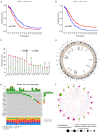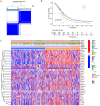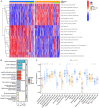Identification of a ferroptosis- and oxidative stress-associated gene signature for prognostic stratification of ovarian cancer
- PMID: 37193145
- PMCID: PMC10182495
Identification of a ferroptosis- and oxidative stress-associated gene signature for prognostic stratification of ovarian cancer
Abstract
Background: Studies have shown that ferroptosis- and oxidative stress-related genes (FORGs) perform crosstalk in ovarian cancer (OC). The specific role of FORGs in OC, however, remains unclear. We aimed to develop a molecular subtype and prognostic model associated with FORGs that could predict OC prognosis and evaluate the infiltration of tumor-associated immune cells.
Methods: Gene expression samples were collected from the GEO (GSE53963) and Cancer Genome Atlas (TCGA) databases. Kaplan-Meier analysis was used to evaluate prognostic efficacy. Unsupervised clustering was applied to identify molecular subtypes, which was followed by tumor immune cell infiltration and functional enrichment analyses. Subtype-related differentially expressed genes (DEGs) were identified and used to establish prognostic models. Associations between the model and immune checkpoint expression, stromal scores, and chemotherapy were investigated.
Results: OC patients were categorized into two FORG subtypes based on the expression characteristics of 19 FORGs. Molecular subtypes associated with patient prognosis, immune activity, and energy metabolism pathways were identified. Subsequently, DEGs in the two FORG subtypes were identified and used in prognostic models. We identified six signature genes (MEGF8, ECE1, SASH1, ARHGEF16, PLXNA1, and FCGBP) with LASSO analysis to assess the risk of OC. Patients in the high-risk group had poor prognoses and immunosuppression, while the risk scores were significantly associated with immune checkpoint expression, stromal scores, and chemotherapy sensitivity.
Conclusions: Our novel clustering algorithm was used to create distinct clusters of OC patients and a prognostic model was developed that accurately predicted patient outcomes and chemotherapy responses. This approach offers effective precision medicine for OC patients.
Keywords: Ferroptosis; ovarian cancer; oxidative stress; prognosis.
AJTR Copyright © 2023.
Conflict of interest statement
None.
Figures






References
-
- Webb PM, Jordan SJ. Epidemiology of epithelial ovarian cancer. Best Pract Res Clin Obstet Gynaecol. 2017;41:3–14. - PubMed
-
- Block MS, Dietz AB, Gustafson MP, Kalli KR, Erskine CL, Youssef B, Vijay GV, Allred JB, Pavelko KD, Strausbauch MA, Lin Y, Grudem ME, Jatoi A, Klampe CM, Wahner-Hendrickson AE, Weroha SJ, Glaser GE, Kumar A, Langstraat CL, Solseth ML, Deeds MC, Knutson KL, Cannon MJ. Th17-inducing autologous dendritic cell vaccination promotes antigen-specific cellular and humoral immunity in ovarian cancer patients. Nat Commun. 2020;11:5173. - PMC - PubMed
-
- Wang X, Xu Y, Dai L, Yu Z, Wang M, Chan S, Sun R, Han Q, Chen J, Zuo X, Wang Z, Hu X, Yang Y, Zhao H, Hu K, Zhang H, Chen W. A novel oxidative stress- and ferroptosis-related gene prognostic signature for distinguishing cold and hot tumors in colorectal cancer. Front Immunol. 2022;13:1043738. - PMC - PubMed
LinkOut - more resources
Full Text Sources
Miscellaneous
